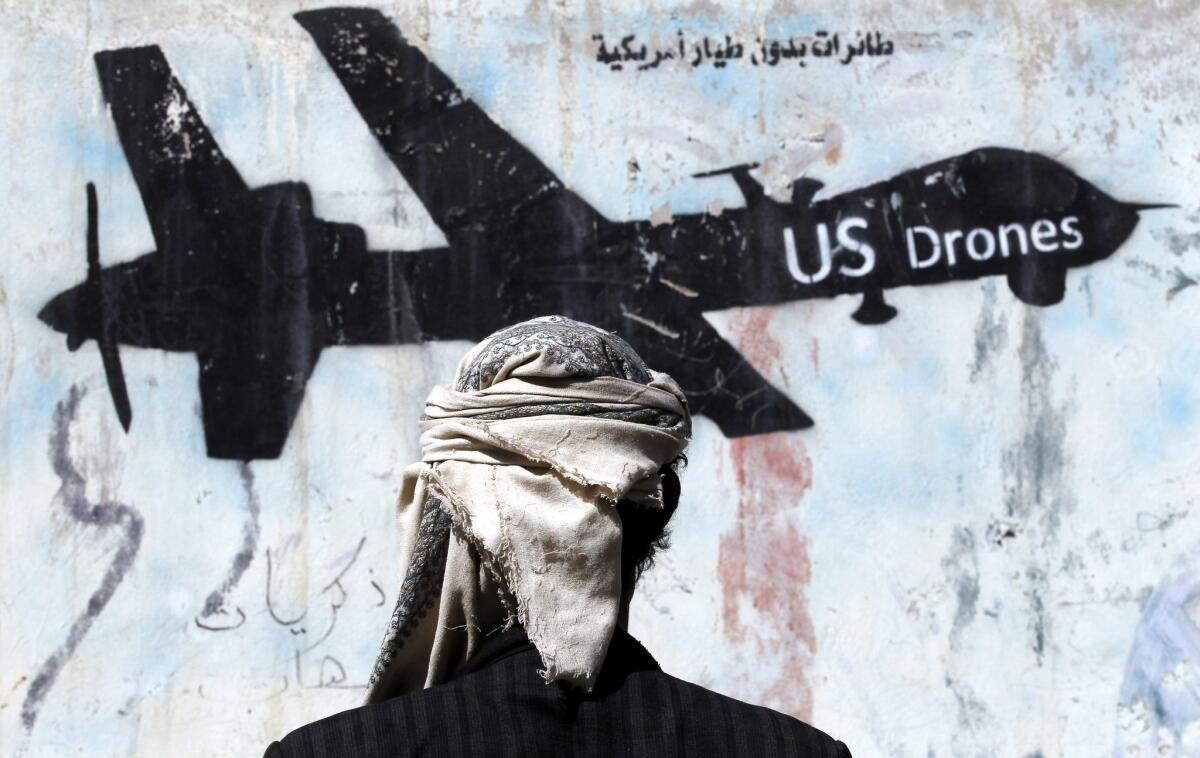What happened the night a U.S. commando was killed in combat, the first such death of Trump’s presidency

Reporting from Beirut — It was past midnight on a moonless night in central Yemen, and Ahmad Jawfi was preparing to go to sleep when he heard the dull buzz of drones overhead. Drones were nothing new, so he and others paid little attention.
But soon, a military operation unfolded that left 14 Al Qaeda fighters dead and took the lives of at least 11 women and children and one U.S. commando. The operation last Sunday on the village of Yakla by SEAL Team 6 was to showcase the Trump administration’s decisiveness in the fight against Al Qaeda.
The attack, the first special operations raid authorized by President Trump, targeted the house of a suspected leader of Al Qaeda in the Arabian Peninsula named Abdel Raouf Dhahab. Jawfi, a tribal leader, was visiting the Dhahab household as part of a tribal mediation.
On Jan. 28, hours before U.S. and Emirati special operations commandos slipped into Yakla early the next morning, residents said they heard drones.
“I was right beside the house preparing a place to go to sleep,” Jawfi said in a phone interview Friday. Drone attacks had struck the area before, but now the buzzing was replaced by new sounds.
“Some time in the early morning … we heard shooting from three sides of where we were,” Jawfi said.
Jawfi ran into the house, thinking it was another drone attack.
“But then we saw American soldiers everywhere.”
It was the start of a firefight that lasted almost an hour, with the SEALs attacking with small arms and grenades before they called in AV-8B Harrier attack jets and helicopter gunships to help repel counter-attacks, according to U.S. officials.
Anybody leaving the house was hit and killed … and people in here have nothing but Kalashnikovs.
— Saleh Mohsen Amery, raid survivor
Another survivor of the raid, Saleh Mohsen Amery, said his house was attacked and his daughter killed. Her 4-year-old son survived.
“They attacked the mosque, school, medical unit and a prison in the area,” he said.
He added, “Anybody leaving the house was hit and killed … and people in here have nothing but Kalashnikovs,” or AK-47s, to defend themselves.
After the fighting stopped, Amery said, people were too terrified to immediately hospitalize any of the wounded.
“We feared the planes would attack again,” he said. “Most people were taken to the hospital at 6 in the morning.”
Among the dead was Nawar Awlaki, the 8-year-old daughter of Anwar Awlaki, the charismatic Yemeni American cleric who emerged as an Al Qaeda in the Arabian Peninsula spokesman and spiritual leader before he was killed six years ago in a CIA drone strike.
Her uncle, Ammar Awlaki, posted a picture on his official Facebook page Monday of a smiling Nawar wearing a red skirt and a red ribbon in her hair. He claimed that she had been shot several times, once in the neck, and that she bled for two hours before she died.
The girl “kept on reassuring her mother as she was bleeding. ‘Don’t cry, Mother. I’m fine, I’m fine,’ ” he wrote. “When dawn prayers came, her soul parted from her little body.”
Capt. Jeff Davis, a Pentagon spokesman, told reporters Monday that local reports of female civilian casualties should be taken with “a grain of salt,” because several women took up fighting positions and fired on U.S. forces. By Wednesday, U.S. Central Command acknowledged there were noncombatants, including children, among the casualties.
The civilian casualties apparently occurred when aerial gunfire was brought in to fight “against a determined enemy that included armed women firing from prepared fighting positions,” Central Command said.
The raid claimed the life of Chief Special Warfare Operator William “Ryan” Owens, 36.
Three other commandos were wounded but are expected to survive their injuries, officials said. An MV-22 Osprey aircraft was damaged after making what the Pentagon called “a hard landing,” injuring three additional U.S. service members. To prevent it from falling into enemy hands, the $70-million aircraft was destroyed.
Al Qaeda in the Arabian Peninsula, known as AQAP, claimed that “American soldiers shot children and women in cold blood and left the police dogs to crunch on the corpses of the dead.”
U.S. intelligence agencies consider AQAP one of Al Qaeda’s most dangerous offshoots. The group attempted to destroy a U.S.-bound airliner over Detroit in 2009 and claimed responsibility for the mass shooting that killed 12 people at the satirical magazine Charlie Hebdo in Paris in 2015.
The Pentagon signed off on the Yemen operation Dec. 19, and other agencies gave their approval in the ensuing weeks.
Former Obama administration officials said Barack Obama didn’t feel comfortable authorizing the operation because it was scheduled to take place after he left office — on Jan. 28, the next moonless night in Yemen.
On Jan. 24, new Defense Secretary James Mattis conveyed his support for the operation and forwarded it to the White House.
Trump dined the next day with an expanded team, including Mattis, Joint Chiefs of Staff Chairman Joseph Dunford and various military and administration officials, among them Vice President Mike Pence, chief strategist Steve Bannon, National Security Advisor Michael Flynn and CIA Director Mike Pompeo.
That was when Trump gave his approval.
The White House said the Obama administration had approved the raid, but former Obama officials took to social media to say the proposal had not gotten that far.
As for Abdel Raouf Dhahab, the target of the operation, he was among those killed. Farea Muslimi, chairman of Sanaa Center for Strategic studies, said his death will stir anti-U.S. sentiment — not because he belonged to AQAP but because he didn’t.
Ahmad Salmani, another local from Yakla, said as much. “Dhahab is not AQAP, and everyone knows that he is a tribal sheikh and has nothing to do with AQAP,” Salmani said in an interview. “Because of this, now everyone... is willing to risk his life to kill a U.S. soldier.”
On Friday, an embarrassing coda to the raid emerged.
The U.S. military released what it claimed was sensitive intelligence seized during the assault — video showing jihadists building a bomb — only to discover that the video had been posted online in 2007.
One of the raid’s goals was to collect the computers, electronic devices and other information inside the AQAP suspected headquarters. The 2007 video was quickly taken down.
Special correspondent Bulos reported from Beirut and Times staff writer Hennigan from Washington.
ALSO
Following up on tough talk, Trump administration adds sanctions on Iran
Israeli officials look ahead to working with Trump after White House settlement statements
For Syrians stuck in limbo in Lebanon, Trump’s ban will mean harder times ahead
More to Read
Sign up for Essential California
The most important California stories and recommendations in your inbox every morning.
You may occasionally receive promotional content from the Los Angeles Times.










